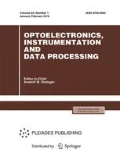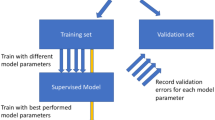Abstract
A new method for testing the hypothesis of the independence of two-dimensional random variables is proposed. The method under consideration is based on the use of a nonparametric algorithm for pattern recognition that meets the maximum likelihood criterion. In contrast to the traditional problem statement, there is no training sample a priori. The initial information is represented by statistical data that make up the values of two-dimensional random variables. The laws of distribution of random variables in classes are estimated from the initial statistical data for the conditions of their dependence and independence. When choosing the optimal blur coefficients for nonparametric estimates of probability densities, the maximum of the likelihood functions is used as a criterion. Under these conditions, estimates of the probability of pattern recognition errors in classes are calculated. Based on the minimum value of the estimate of the probability of an error in pattern recognition, a decision is made on the independence or dependence of random variables. The effectiveness of the developed method is confirmed by the results of computational experiments when testing the hypothesis of the independence or linear dependence of two-dimensional random variables.

Similar content being viewed by others
REFERENCES
A. V. Lapko and V. A. Lapko, ‘‘Properties of nonparametric estimates of multidimensional probability density of independent random variables,’’ Inf. Sci. Control Syst. 31 (1), 166–174 (2012).
A. V. Lapko and V. A. Lapko, ‘‘Nonparametric estimation of probability density of independent random variables,’’ Inf. Sci. Control Syst. 29 (3), 118–124 (2011).
A. V. Lapko and V. A. Lapko, ‘‘Effect of a priori information about independence multidimensional random variables on the properties of their nonparametric density probability estimates,’’ Sist. Upr. Inf. Tekhnol. 48 (2.1), 164–167 (2012).
A. V. Lapko and V. A. Lapko, ‘‘Properties of the nonparametric decision function with a priori information on independence of attributes of classified objects,’’ Optoelectron., Instrum. Data Process. 48, 416–422 (2012). https://doi.org/10.3103/S8756699012040139
V. S. Pugachev, Theory of Probability and Mathematical Statistics (Fizmatlit, Moscow, 2002).
A. V. Lapko and V. A. Lapko, ‘‘Nonparametric algorithms of pattern recognition in the problem of testing a statistical hypothesis on identity of two distribution laws of random variables,’’ Optoelectron., Instrum. Data Process. 46, 545–550 (2010). https://doi.org/10.3103/S8756699011060069
A. V. Lapko and V. A. Lapko, ‘‘Comparison of empirical and theoretical distribution functions of a random variable on the basis of a nonparametric classifier,’’ Optoelectron., Instrum. Data Process. 48, 37–41 (2012). https://doi.org/10.3103/S8756699012010050
A. V. Lapko and V. A. Lapko, ‘‘A technique for testing hypotheses for distributions of multidimensional spectral data using a nonparametric pattern recognition algorithm,’’ Comput. Optics 43, 238–244 (2019). https://doi.org/10.18287/2412-6179-2019-43-2-238-244
E. Parzen, ‘‘On estimation of a probability density function and mode,’’ Ann. Math. Stat. 33, 1065–1076 (1962). https://doi.org/10.1214/aoms/1177704472
V. A. Epanechnikov, ‘‘Non-parametric estimation fo a multivariate probability density,’’ Theory Probab. Its Appl. 14, 153–158 (1969). https://doi.org/10.1137/1114019
R. P. W. Duin, ‘‘On the choice of smoothing parameters for parzen estimators of probability density functions,’’ IEEE Trans. Comput. C-25, 1175–1179 (1976). https://doi.org/10.1109/TC.1976.1674577
Z. I. Botev and D. P. Kroese, ‘‘Non-asymptotic bandwidth selection for density estimation of discrete data,’’ Methodol. Comput. Appl. Probab. 10, 435 (2008). https://doi.org/10.1007/s11009-007-9057-z
M. Rudemo, ‘‘Empirical choice of histogram and kernel density estimators,’’ Scand. J. Stat. 9, 65–78 (1982).
A. W. Bowman, ‘‘A comparative study of some kernel-based non-parametric density estimators,’’ J. Stat. Comput. Simul. 21, 313–327 (1982). https://doi.org/10.1080/00949658508810822
P. Hall, ‘‘Large-sample optimality of least squares cross-validation in density estimation,’’ Ann. Statist. 11, 1156–1174 (1983).
M. Jiang and S. B. Provost, ‘‘A hybrid bandwidth selection methodology for kernel density estimation,’’ J. Stat. Comput. Simul. 84, 614–627 (2014). https://doi.org/10.1080/00949655.2012.721366
S. Dutta, ‘‘Cross-validation revisited,’’ Commun. Stat. Simul. Comput. 45, 472–490 (2016). https://doi.org/10.1080/03610918.2013.862275
N.-B. Heidenreich, A. Schindler, and S. Sperlich, ‘‘Bandwidth selection for kernel density estimation: a review of fully automatic selectors,’’ AStA Adv. Stat. Anal. 97, 403–433 (2013). https://doi.org/10.1007/s10182-013-0216-y
Q. Li and J. S. Racine, Nonparametric Econometrics: Theory and Practice (Princeton Univ. Press, Princeton, 2007).
A. V. Lapko and V. A. Lapko, ‘‘Method of fast bandwidth selection in a nonparametric classifier corresponding to the a posteriori probability maximum criterion,’’ Optoelectron., Instrum. Data Process. 55, 597–605 (2019). https://doi.org/10.3103/S8756699019060104
D. W. Scott, Multivariate Density Estimation: Theory, Practice, and Visualization (Wiley, New Jersey, 2015). https://doi.org/10.1002/9780470316849
S. J. Sheather, ‘‘Density estimation,’’ Stat. Sci. 19, 588–597 (2004). https://doi.org/10.1214/088342304000000297
B. W. Silverman, Density Estimation for Statistics and Data Analysis (Chapman and Hall, London, 1986).
A. S. Sharakshane, I. G. Zheleznov, and V. A. Ivnitskii, Complex Systems (Vysshaya Shkola, Moscow, 1977).
Funding
The research was carried out with the financial support of the Russian Foundation for Basic Research, the Government of the Krasnoyarsk krai, and the Krasnoyarsk Regional Science Foundation (project no. 20-41-240001).
Author information
Authors and Affiliations
Corresponding author
Additional information
Translated by T. N. Sokolova
About this article
Cite this article
Lapko, A.V., Lapko, V.A. Testing the Hypothesis of the Independence of Two-Dimensional Random Variables Using a Nonparametric Algorithm for Pattern Recognition. Optoelectron.Instrument.Proc. 57, 149–155 (2021). https://doi.org/10.3103/S8756699021020114
Received:
Revised:
Accepted:
Published:
Issue Date:
DOI: https://doi.org/10.3103/S8756699021020114




